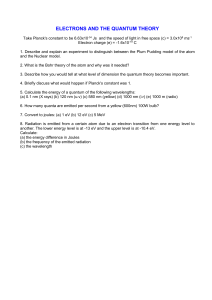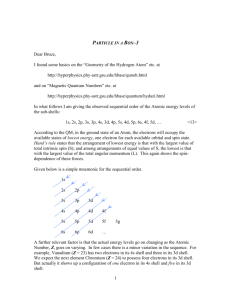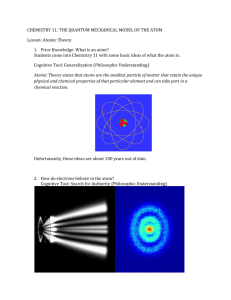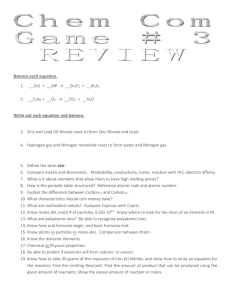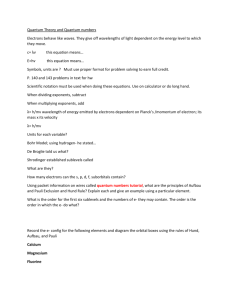Fall 2005 Final
advertisement
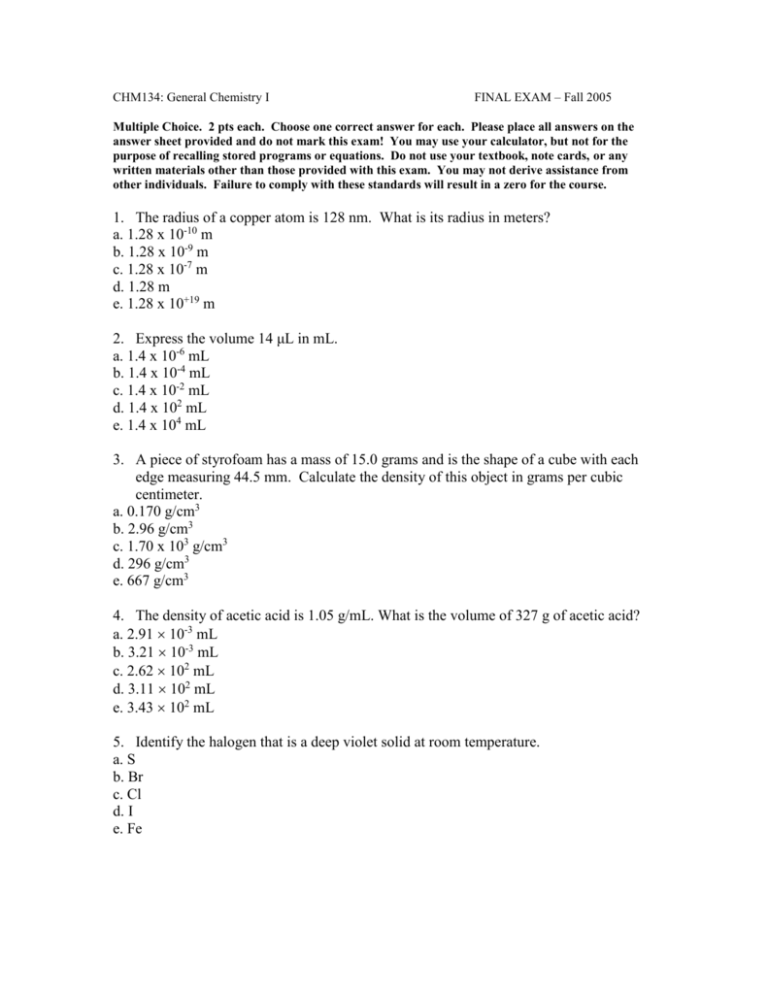
CHM134: General Chemistry I FINAL EXAM – Fall 2005 Multiple Choice. 2 pts each. Choose one correct answer for each. Please place all answers on the answer sheet provided and do not mark this exam! You may use your calculator, but not for the purpose of recalling stored programs or equations. Do not use your textbook, note cards, or any written materials other than those provided with this exam. You may not derive assistance from other individuals. Failure to comply with these standards will result in a zero for the course. 1. The radius of a copper atom is 128 nm. What is its radius in meters? a. 1.28 x 10-10 m b. 1.28 x 10-9 m c. 1.28 x 10-7 m d. 1.28 m e. 1.28 x 10+19 m 2. Express the volume 14 μL in mL. a. 1.4 x 10-6 mL b. 1.4 x 10-4 mL c. 1.4 x 10-2 mL d. 1.4 x 102 mL e. 1.4 x 104 mL 3. A piece of styrofoam has a mass of 15.0 grams and is the shape of a cube with each edge measuring 44.5 mm. Calculate the density of this object in grams per cubic centimeter. a. 0.170 g/cm3 b. 2.96 g/cm3 c. 1.70 x 103 g/cm3 d. 296 g/cm3 e. 667 g/cm3 4. The density of acetic acid is 1.05 g/mL. What is the volume of 327 g of acetic acid? a. 2.91 10-3 mL b. 3.21 10-3 mL c. 2.62 102 mL d. 3.11 102 mL e. 3.43 102 mL 5. Identify the halogen that is a deep violet solid at room temperature. a. S b. Br c. Cl d. I e. Fe 6. Which metal is easily distinguished by its color? a. Ag b. Ba c. Cu d. I e. Ni 7. What alkali metal is in the fourth period? a. Ca b. K c. Na d. Sr e. Sc 8. How many significant figures are in the measurement 0.080090 m? a. 2 b. 3 c. 4 d. 5 e. 6 9. The isotope 81Br contains ___electrons, ___protons, and ___neutrons. a. 35e, 46p, 35n b. 35e, 35p, 46n c. 46e, 46p, 35n d. 35e, 46p, 35n e. 46e, 35p, 79n 10. From the results of his gold foil experiment, Ernest Rutherford concluded that a. electrons have a charge of –1.602 10-19 C. b. atoms contain equal numbers of protons and electrons. c. uranium ores emit a form of radiation that affect photographic plates. d. alpha particles are helium nuclei. e. atoms are composed of a small, dense nucleus surrounded by a cloud of electrons. 11. An atomic mass unit (u) is defined as a. the mass of one hydrogen-1 atom. b. 1/8 the mass of one oxygen-16 atom. c. 1/12 the mass of one carbon-12 atom. d. 1.99 10-23 g. e. the sum of the masses of one proton, one neutron, and one electron. 12. Calculate the number of moles of sodium in 1.2 x 1024 atoms of Na. a. 5.0 mol Na b. 2.0 mol Na c. 3.0 x 102 mol Na d. 25 mol Na e. 0.66 mol Na 13. Calculate the mass of 3.00 moles of sulfur, S. a. 96.2 g b. 7.66 g c. 0.00402 g d. 4.98 x 10-24 g e. 10.6 g 14. Calculate the mass of 4.60 x 1025 atoms of neon? a. 4.38 x 10-5 g b. 0.0382 g c. 0.264 g d. 5.54 x 102 g e. 1.54 x 103 g 15. An element consists of two isotopes. The abundance of one isotope is 95.72% and its atomic mass is 114.9041 u. The atomic mass of the second isotope is 112.9043 u. What is the average atomic mass of the element? a. 113.9 u b. 113.0 u c. 112.9 u d. 114.8 u e. 115.1 u 16. A local radio station broadcasts at 98.5MHz (MHz = 106Hz), what is the wavelength of these radio waves? a. 3.05m b. 0.328m c. 1.48 x 1041m d. 2.21 x 10-42m 17. A microwave has a frequency of 3.10 x 1010Hz, what is the energy emitted by these waves? a. 2.14 x 10-44J b. 4.68 x 1043J c. 2.05 x 10-23J d. 9.30 x 1018J 18. Which of the following is a possible set of quantum numbers for the 5f orbital? a) n = 5, l = 4, ml = -4 b) n = 5, l = 3, ml = -2 c) n = 5, l = 4, ml = -5 d) n = 4, l = 3, ml = -4 19. How many electrons can have the first two quantum numbers n = 3 and l = 2? a. 1 b. 5 c. 7 d. 10 20. The size of an atomic orbital is associated with a. The principal quantum number (n) b. The angular momentum quantum number(l) c. The magnetic quantum number (ml) d. The spin quantum number (ms) 21. For the four quantum numbers needed to describe an electron, which of these combinations are NOT possible? a) (1,0,0,+½) b) (2,1,1,-½) c) (3,2,-2,-½) d) (1,0,-1,+½) e) all 22. Which of the following diagrams represent p-orbitals? (I) (II) a) (I) only d) (II) and (IV) (IV) (III) b) (II) only e) (I) and (II) c (III) only 23. How many electrons can be described by the following quantum numbers? n = 3, l = 2, ml = -1, ms = +1/2 a) 0 b) 1 c) 2 d) 3 e) 6 24. How many electrons can be described by the quantum numbers n = 5, l = 2, ms = -1/2? a) 1 b) 3 c) 5 d) 7 e) 9 25. The change in energy for the following reaction is referred to as ________ for fluorine. F(g) + e- → F-(g) a) oxidation energy b) electron affinity c) electronegativity energy d) first ionization energy e) second ionization energy 26. Identify the Row Two element that is consistent with the data below. IE1 IE2 IE3 IE4 IE5 1.09 2.35 4.62 6.22 37.83 a)Be b)C c)B d)N e)O IE6 47.28 27. If the energy of 1.00 mole of photons is 441 kJ, what is the wavelength of the light? a) 271 nm b) 451 nm c) 680 nm d) 732 nm e) 891 nm 28. What is the electron configuration for a lead atom? a) [Xe]6s26p2 b) [Xe]4f145d106s26p2 c) [Kr]5d106s26p2 d) [Xe]5d106s26p2 e) [Kr]4d104f145d2 29. Identify the ions in (NH4)2Cr2O7. a) N3-, H+, Cr3+ and O2b) N3-, H-, Cr3+ and O2c) NH3 and H2Cr2O7 d) NH4+ and Cr2O72e) NH4+, Cr3+ and O230. All of the following statements concerning ionic compounds are correct EXCEPT a) as the ion charges increase, the attraction between the ions increases. b) ionic compounds form extended 3-dimensional networks called crystal lattices. c) although not ductile like metals, ionic compounds are often malleable. d) positive and negative ions are attracted to each other by electrostatic forces. e) ionic crystals tend to be rigid, and they cleave along planes. 31. A nitrogen atom has how many valence electrons? a) 2 b) 3 c) 5 d) 6 e) 8 d) 89% e) 91% d) 12.4 mg e) 8.99 mg 32. What is the mass percent of Oxygen in water? a) 10% b) 33% c) 73% 33. What is the mass of 3.00 moles of Aluminum? a) 80.9 g b) 12.4 g c) 8.99 g 34. How many moles of CaCl2 are present in 10. grams of CaCl2? a) 0.270 b) 0.020 c) 11 d) 1100 e) 0.090 35. How many moles of hydrogen atoms are contained in a 50.000 gram sample of acetone? Here is a structural formula for acetone: H H H C H H C C O H acetone a) 5.1655 b) 6.0000 c) 0.86091 d) 58.078 e) 1.1616 36. Which one of the following molecules has a dipole moment (is polar)? a) CI4 b) PF5 c) NCl3 d) SO3 e) O2 37. How many of the following molecules have a planar (flat) geometry? SF6 a) 1 XeCl4 b) 2 NH3 c) 3 BF3 PCl5 d) 4 e) 5 d. OF2 e) NH3 38. Which one of the following molecules is linear? a. H2O b. O3 c. BeCl2 39. A molecule that has no lone pairs and 5 bonds at the central atom will be: a) bent b) linear c) trigonal-planar d) trigonal-pyramidal e) trigonal-bipyramidal 40. What is the molecular geometry around a central atom that has three bonds and one lone electron-pair? a) bent b) linear c) trigonal-planar d) trigonal-pyramidal e) trigonal-bipyramidal 41. According to MO theory, which species has the shortest bond length? a) O22+ b) O2+ c) O2 d) O2- e) O22- 42. Which of these statements is true: a. Double bonds are shorter than triple bonds. b. Double bonds are shorter than single bonds. c. Double bonds are longer than single bonds. d. Both (a) and (c) are both true. e. None of these are true. 43. Which of the following are possible Lewis structures for C2H5NO? H H O C C H H H O C C N H C C H H H (2) b) 2 (3) c) 3 d) 2 and 3 45. How many sigma (σ) bonds and pi (π) bonds are in the following molecule? O H C N C C H O H a) five σ and two π b) five σ and three π c) five σ and four π d) nine σ and three π e) nine σ and four π 46. What type of reaction is described by this balanced equation? H e) 1, 2, and 3 44. What is the formal charge on each atom in a hypobromite ion, OBr-? a) O = -2, Br = -1 b) O = -2, Br = +1 c) O = -1, Br = +1 d) O = -1, Br = 0 e) O = 0, Br = -1 C H N H (1) O N H a) 1 H H 3 Na2O(aq) + 2 H3PO4(aq) → 2 Na3PO4(aq) + 3 H2O(l) a. oxidation-reduction b. precipitation c. acid-base d. gas forming 47. What mass of the excess reactant remains after reacting 8.51 g of magnesium with 3.45 g of nitrogen gas? 3 Mg(s) + N2(g) → Mg3N2(s) a. 5.52 g Mg b. 0.18 g N2 c. 5.06 g Mg d. 0.061 g N2 48. What precipitate forms from the reaction of aqueous solutions of copper (II) acetate and potassium phosphate? a. CuPO4 b. (CH3CO2)3PO4 c. KCH3CO2 d. Cu3(PO4)2 49. Identify the reducing agent in this balanced redox reaction. 5 H2C2O4(aq) + 2 KMnO4(aq) + 6 HCl(aq) → 2 MnCl2(aq) + 10 CO2(g) + 8 H2O(l) + 2 KCl(aq) a. H2C2O4 b. KMnO4 c. CO2 d. H2O 50. Metals react with oxygen to give oxides with the general formula MxOy. Write a balanced chemical equation for the reaction of iron with oxygen to yield iron(III) oxide. a. b. c. d. Fe(s) + O2(g) → FeO2(s) 2 Fe(s) + 3 O2(g) → Fe2O3(s) 3 Fe(s) + O2(g) → Fe3O2(s) 4 Fe(s) + 3 O2(g) → 2 Fe2O3(s) 51. What mass of rhombic sulfur is required to react with 0.956 g of chlorine gas according to the following reaction? S8(l) + 4 Cl2(g) → 4 S2Cl2(l) a. 0.865 g b. 0.0135 g c. 0.239 g d. 3.46 g 52. What is the concentration of a solution prepared by dissolving 2.583 grams of sodium sulfate in enough water to make 250. mL of solution? a. 0.132 M b. 0.0868 M c. 0.0727 M d. 7.27×10-5 M 53. What mass of oxalic acid (H2C2O4) is used to prepare 400. mL of an aqueous solution of oxalic acid if 22.50 mL of the solution are titrated with 12.62 mL of 0.1038-M potassium permanganate according the following balanced equation? 5 H2C2O4(aq) + 2 KMnO4(aq) + 6 HCl(aq) → 2 MnCl2(aq) + 10 CO2(g) + 8 H2O(l) + 2 KCl(aq) a. 2.10 g b. 10.5 g c. 0.295 g d. 5.24 g 54. What is the total number of electrons transferred in the redox reaction described above when 2.00 moles of KMnO4 are reacted with excess H2C2O4 and HCl? a. 6.02×1024 b. 1.20×1024 c. 10 d. 5 55. A 2.50-L solution of hydrobromic acid is prepared by dissolving enough HBr(g) in the water so that the solution has a pH of 3.728. What mass of HBr was dissolved in the water? a. 0.0151 g b. 0.0378 g c. 115 g d. 1.08×106 g 56. What are the spectator ions in the reaction between aqueous solutions of barium hydroxide and sulfuric acid? a. Ba2+ and OH1- b. Ba2+ and SO42- c. H1+ and OH1- d. none 57. Iron reacts with hydrochloric acid to produce iron(II) chloride and hydrogen gas. Fe(s) + 2 HCl(aq) → FeCl2(aq) + H2(g) How many moles of HCl will react with 4.6 moles of Fe? a. 2.3 mol b. 9.2 mol c. 6.9 mol d. 4.6 mol 58. Sodium carbonate reacts with hydrochloric acid as shown below in an unbalanced chemical equation. What mass of CO2 is produced from the reaction of 2.94 g Na2CO3 with excess HCl? Na2CO3(s) + HCl(aq) → NaCl(aq) + CO2(g) + H2O( ) a. 1.22 g b. 2.44 g c. 2.94 g d. 5.88 g 59. Which of the following compounds will be soluble in water: KNO3, Ca3(PO4)2, CuCl2, and Fe2S3? a. b. c. d. KNO3 and Ca3(PO4)2 KNO3 and CuCl2 Ca3(PO4)2 and Fe2S3 CuCl2 and Fe2S3 60. A precipitate will form when an aqueous solution of AgNO3 is added to an aqueous solution of ________. a. KNO3 b. Cu(NO3)2 c. KI d. Ca(ClO4)2 e. NaNO3

